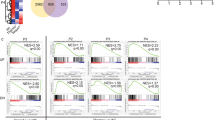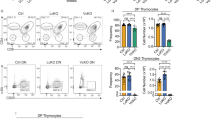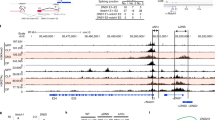Abstract
Thymocyte selection and differentiation requires extracellular signal–regulated kinase (Erk) signaling, but transcription factor substrates of Erk in thymocytes are unknown. We have characterized the function of SAP-1 (Elk4), an Erk-regulated transcription factor, in thymocyte development. Early thymocyte development was normal, but single-positive thymocyte and peripheral T cell numbers were reduced, reflecting a T cell–autonomous defect. T cell receptor–induced activation of SAP-1 target genes such as Egr1 was substantially impaired in double-positive thymocytes, although Erk activation was normal. Analysis of T cell receptor transgenes showed that positive selection was reduced by 80–90% in SAP-1-deficient mice; heterozygous mice showed a moderate defect. Negative selection was unimpaired. SAP-1 thus directly links Erk signaling to the transcriptional events required for thymocyte positive selection.
This is a preview of subscription content, access via your institution
Access options
Subscribe to this journal
Receive 12 print issues and online access
$209.00 per year
only $17.42 per issue
Buy this article
- Purchase on Springer Link
- Instant access to full article PDF
Prices may be subject to local taxes which are calculated during checkout







Similar content being viewed by others
Accession codes
Accessions
GenBank/EMBL/DDBJ
References
Starr, T.K., Jameson, S.C. & Hogquist, K.A. Positive and negative selection of T cells. Annu. Rev. Immunol. 21, 139–176 (2003).
Germain, R.N. T-cell development and the CD4-CD8 lineage decision. Nat. Rev. Immunol. 2, 309–322 (2002).
Basson, M.A. & Zamoyska, R. The CD4/CD8 lineage decision: integration of signalling pathways. Immunol. Today 21, 509–514 (2000).
Alberola-Ila, J. & Hernandez-Hoyos, G. The Ras/MAPK cascade and the control of positive selection. Immunol. Rev. 191, 79–96 (2003).
Palmer, E. Negative selection—clearing out the bad apples from the T-cell repertoire. Nat. Rev. Immunol. 3, 383–391 (2003).
Sharp, L.L., Schwarz, D.A., Bott, C.M., Marshall, C.J. & Hedrick, S.M. The influence of the MAPK pathway on T cell lineage commitment. Immunity 7, 609–618 (1997).
Crompton, T., Gilmour, K.C. & Owen, M.J. The MAP kinase pathway controls differentiation from double-negative to double-positive thymocyte. Cell 86, 243–251 (1996).
Sugawara, T., Moriguchi, T., Nishida, E. & Takahama, Y. Differential roles of Erk and p38 MAP kinase pathways in positive and negative selection of T lymphocytes. Immunity 9, 565–574 (1998).
Mariathasan, S., Ho, S.S., Zakarian, A. & Ohashi, P.S. Degree of Erk activation influences both positive and negative thymocyte selection. Eur. J. Immunol. 30, 1060–1068 (2000).
Mariathasan, S. et al. Duration and strength of extracellular signal-regulated kinase signals are altered during positive versus negative thymocyte selection. J. Immunol. 167, 4966–4973 (2001).
Bommhardt, U., Scheuring, Y., Bickel, C., Zamoyska, R. & Hunig, T. MEK activity regulates negative selection of immature CD4+CD8+ thymocytes. J. Immunol. 164, 2326–2337 (2000).
Sharp, L.L. & Hedrick, S.M. Commitment to the CD4 lineage mediated by extracellular signal-related kinase mitogen-activated protein kinase and lck signaling. J. Immunol. 163, 6598–6605 (1999).
Bommhardt, U., Basson, M.A., Krummrei, U. & Zamoyska, R. Activation of the extracellular signal-related kinase/mitogen-activated protein kinase pathway discriminates CD4 versus CD8 lineage commitment in the thymus. J. Immunol. 163, 715–722 (1999).
Bettini, M., Xi, H., Milbrandt, J. & Kersh, G.J. Thymocyte development in early growth response gene 1-deficient mice. J. Immunol. 169, 1713–1720 (2002).
Bain, G. et al. Regulation of the helix-loop-helix proteins, E2A and Id3, by the Ras-Erk MAPK cascade. Nat. Immunol. 2, 165–171 (2001).
Rivera, R.R., Johns, C.P., Quan, J., Johnson, R.S. & Murre, C. Thymocyte selection is regulated by the helix-loop-helix inhibitor protein, Id3. Immunity 12, 17–26 (2000).
Miyazaki, T. & Lemonnier, F.A. Modulation of thymic selection by expression of an immediate-early gene, early growth response 1 (Egr-1). J. Exp. Med. 188, 715–723 (1998).
Carleton, M. et al. Early growth response transcription factors are required for development of CD4−CD8− thymocytes to the CD4+CD8+ stage. J. Immunol. 168, 1649–1658 (2002).
Calnan, B.J., Szychowski, S., Chan, F.K., Cado, D. & Winoto, A. A role for the orphan steroid receptor Nur77 in apoptosis accompanying antigen-induced negative selection. Immunity 3, 273–282 (1995).
Cheng, L.E., Chan, F.K., Cado, D. & Winoto, A. Functional redundancy of the Nur77 and Nor-1 orphan steroid receptors in T-cell apoptosis. Eur. J. Immunol. 27, 2048–2056 (1997).
Lee, S.L. et al. Unimpaired thymic and peripheral T cell death in mice lacking the nuclear receptor NGFI-B (Nur77). Science 269, 532–535 (1995).
Treisman, R. Ternary complex factors: growth factor regulated transcriptional activators. Curr. Opin. Genet. Dev. 4, 96–101 (1994).
Shaw, P.E., Schroter, H. & Nordheim, A. The ability of a ternary complex to form over the serum response element correlates with serum inducibility of the human c-fos promoter. Cell 56, 563–572 (1989).
Herrera, R.E., Shaw, P.E. & Nordheim, A. Occupation of the c-fos serum response element in vivo by a multi-protein complex is unaltered by growth factor induction. Nature 340, 68–70 (1989).
Hassler, M. & Richmond, T.J. The B-box dominates SAP-1-SRF interactions in the structure of the ternary complex. EMBO J. 20, 3018–3028 (2001).
Murai, K. & Treisman, R. Interaction of serum response factor (SRF) with the Elk-1 B-box inhibits RhoA-actin signalling to SRF and potentiates transcriptional activation by Elk-1. Mol. Cell. Biol. 22, 7083–7092 (2002).
Hill, C.S. & Treisman, R. Differential activation of c-fos promoter elements by serum, lysophosphatidic acid, G proteins and polypeptide growth factors. EMBO J. 14, 5037–5047 (1995).
McMahon, S.B. & Monroe, J.G. A ternary complex factor-dependent mechanism mediates induction of egr-1 through selective serum response elements following antigen receptor cross-linking in B lymphocytes. Mol. Cell. Biol. 15, 1086–1093 (1995).
Williams, G.T. & Lau, L.F. Activation of the inducible orphan receptor gene nur77 by serum growth factors: dissociation of immediate-early and delayed-early responses. Mol. Cell. Biol. 13, 6124–6136 (1993).
Palestro, G., Turrini, F., Pagano, M. & Chiusa, L. Castleman's disease. Adv. Clin. Path. 3, 11–22 (1999).
Favata, M.F. et al. Identification of a novel inhibitor of mitogen-activated protein kinase kinase. J. Biol. Chem. 273, 18623–18632 (1998).
Price, M.A., Rogers, A.E. & Treisman, R. Comparative analysis of the ternary complex factors Elk-1, SAP-1a and SAP-2 (ERP/NET). EMBO J. 14, 2589–2601 (1995).
Latinkic, B.V., Zeremski, M. & Lau, L.F. Elk-1 can recruit SRF to form a ternary complex upon the serum response element. Nucleic Acids Res. 24, 1345–1351 (1996).
Barnden, M.J., Allison, J., Heath, W.R. & Carbone, F.R. Defective TCR expression in transgenic mice constructed using cDNA-based α- and β-chain genes under the control of heterologous regulatory elements. Immunol. Cell Biol. 76, 34–40 (1998).
Testi, R., D'Ambrosio, D., De Maria, R. & Santoni, A. The CD69 receptor: a multipurpose cell-surface trigger for hematopoietic cells. Immunol. Today 15, 479–483 (1994).
Azzam, H.S. et al. Fine tuning of TCR signaling by CD5. J. Immunol. 166, 5464–5472 (2001).
Davis, S.J. et al. The nature of molecular recognition by T cells. Nat. Immunol. 4, 217–224 (2003).
Ohashi, P.S., Pircher, H., Burki, K., Zinkernagel, R.M. & Hengartner, H. Distinct sequence of negative or positive selection implied by thymocyte T-cell receptor densities. Nature 346, 861–863 (1990).
Mamalaki, C. et al. Positive and negative selection in transgenic mice expressing a T-cell receptor specific for influenza nucleoprotein and endogenous superantigen. Dev. Immunol. 3, 159–174 (1993).
Kisielow, P., Bluthmann, H., Staerz, U.D., Steinmetz, M. & von Boehmer, H. Tolerance in T-cell-receptor transgenic mice involves deletion of nonmature CD4+8+ thymocytes. Nature 333, 742–746 (1988).
Bain, G., Quong, M.W., Soloff, R.S., Hedrick, S.M. & Murre, C. Thymocyte maturation is regulated by the activity of the helix-loop-helix protein, E47. J. Exp. Med. 190, 1605–1616 (1999).
Lau, L.F. & Nathans, D. Expression of a set of growth-related immediate early genes in BALB/c 3T3 cells: coordinate regulation with c-fos or c-myc. Proc. Natl. Acad. Sci. USA 84, 1182–1186 (1987).
Christy, B.A. et al. An Id-related helix-loop-helix protein encoded by a growth factor-inducible gene. Proc. Natl. Acad. Sci. USA 88, 1815–1819 (1991).
Clarkson, R.W., Shang, C.A., Levitt, L.K., Howard, T. & Waters, M.J. Ternary complex factors Elk-1 and Sap-1a mediate growth hormone-induced transcription of egr-1 (early growth response factor-1) in 3T3-F442A preadipocytes. Mol. Endocrinol. 13, 619–631 (1999).
Gong, Q. et al. Disruption of T cell signaling networks and development by Grb2 haploid insufficiency. Nat. Immunol. 2, 29–36 (2001).
Dequiedt, F. et al. HDAC7, a thymus-specific class II histone deacetylase, regulates Nur77 transcription and TCR-mediated apoptosis. Immunity 18, 687–698 (2003).
Yoon, J.K. & Lau, L.F. Transcriptional activation of the inducible nuclear receptor gene nur77 by nerve growth factor and membrane depolarization in PC12 cells. J. Biol. Chem. 268, 9148–9155 (1993).
Cesari, F. et al. Mice deficient for the Ets transcription factor Elk-1 show normal immune responses and mildly impaired neuronal gene activation. Mol. Cell. Biol. 24, 294–305 (2004).
Ayadi, A. et al. Net-targeted mutant mice develop a vascular phenotype and up-regulate egr-1. EMBO J. 20, 5139–5152 (2001).
Zheng, H. et al. The transcription factor Net regulates the angiogenic switch. Genes Dev. 17, 2283–2297 (2003).
Schmitt, T.M. & Zuniga-Pflucker, J.C. Induction of T cell development from hematopoietic progenitor cells by delta-like-1 in vitro . Immunity 17, 749–756 (2002).
Miralles, F., Posern, G., Zaromytidou, A.-I. & Treisman, R. Actin dynamics control SRF activity by regulation of its coactivator MAL. Cell 113, 329–342 (2003).
Acknowledgements
We thank F. Batista, D. Cantrell, C. Dickson, M. Owen, C. Reis e Sousa, K. Weston and R. Zamoyska for discussions and/or comments on the manuscript. We thank W. Heath (Walter and Eliza Hall Institute, Melbourne, Australia) for the OT-II transgenic mice; A. Smith for the targeting vector; Cancer Research UK Biological Resources Unit for animal husbandry; and D. Davies, G. Warne and C. Simpson of the London Research Institute FACS facility for cell sorting and technical support. Supported by Cancer Research UK.
Author information
Authors and Affiliations
Corresponding author
Ethics declarations
Competing interests
The authors declare no competing financial interests.
Supplementary information
Rights and permissions
About this article
Cite this article
Costello, P., Nicolas, R., Watanabe, Y. et al. Ternary complex factor SAP-1 is required for Erk-mediated thymocyte positive selection. Nat Immunol 5, 289–298 (2004). https://doi.org/10.1038/ni1038
Received:
Accepted:
Published:
Issue Date:
DOI: https://doi.org/10.1038/ni1038
This article is cited by
-
Serine-threonine kinases in TCR signaling
Nature Immunology (2014)
-
Decision checkpoints in the thymus
Nature Immunology (2010)
-
Identification of ETS-like transcription factor 4 as a novel androgen receptor target in prostate cancer cells
Oncogene (2008)
-
Territory quality affects female preference in a Lake Victoria cichlid fish
Behavioral Ecology and Sociobiology (2008)
-
Calcineurin sets the bandwidth for discrimination of signals during thymocyte development
Nature (2007)



